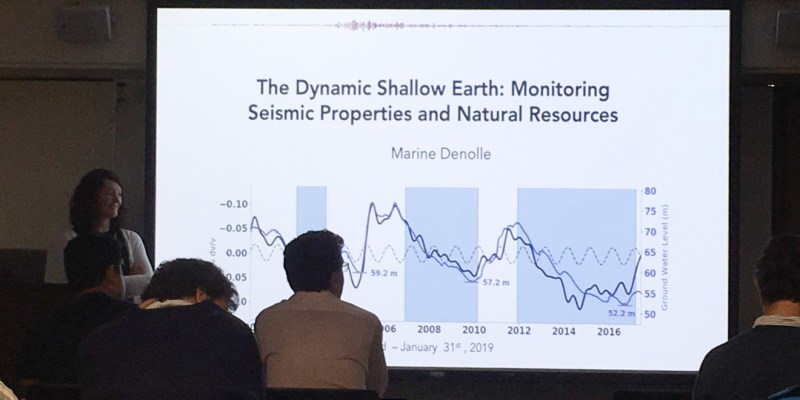A method to monitor seismic hazards — the probability that an earthquake will occur in a specific geographic area — and natural resources such as groundwater was one of many topics addressed by Marine Denolle Ph.D. ’13 in a Thursday lecture on harnessing the seismic properties of Earth’s shallow subsurface. Denolle, who gave her lecture at the Mitchell Earth Sciences Building, studied seismology at Stanford and is currently an earth and planetary sciences assistant professor at Harvard.
At the intersection between the solid Earth and the fluid Earth, the subsurface is unexposed material that is beneath but close to the surface of the ground. Denolle described how Earth’s dynamic subsurface can be affected by a host of differing factors ranging from temperature and precipitation to air pressure. Humans live at these crossroads, relying on these surface properties for food, water, energy and other resources.
Denolle’s initial research interest was piqued by California’s variable weather patterns and sensitive groundwater levels. She later decided to delve deeper into understanding the correlation between natural resources and geological activity, carrying out a series of projects that aim to better monitor groundwater resources and seismic hazards.
One such study involved geologic monitoring in the Merapi Volcano region of Indonesia. Denolle and her team were able to use the ambient seismic field — relatively persistent, non-interpretable vibrations of the ground picked up by a seismometer — to measure the change in seismic wave velocity as a function of time and subsequently relate these measurements back to the observed levels of groundwater in the area.
“This change in [seismic] velocity could be used to track groundwater,” Denolle said, explaining that as velocity decreased, the level of groundwater increased.
In addition to looking at seismic velocity, the team also observed the sensitivity of seismic waves at different frequencies. For this, Denolle’s team focused on changes in groundwater height in the San Gabriel aquifer area in California during the 2012 to 2016 drought. Comparing seismic data with data from a series of wells, her team analyzed how water flows in and out of these urban aquifers.
“We’re still figuring how to interpret the functional shape of the recovery of groundwater, but the nice separation has allowed us to tease out the water level,” Denolle said.
Traditional methods for measuring groundwater level include GPS surveying of surface deformation, interferometric synthetic aperture radar geodesy (inSAR) to see wave phase differences and gravity recovery and climate experiment (GRACE) measurements to see gravity changes in groundwater.
“This method [using seismic velocity] could be a great complementary approach to the existing methods of GPS, inSAR and GRACE,” Denolle explained. “It comes with flexibility in time resolution and spatial resolution.”
In addition to using seismic velocity as a prediction of fluctuating groundwater resources, Denolle and her team are working on using this geological measurement to calculate the probability that earthquakes will occur in specific geographic areas. To this end, Denolle’s group studied the long-term temporal changes in the Kanto Basin of Japan to uncover the interplay between groundwater level and geological activity.
Looking toward the future, she hopes to further understand and quantify the effects of natural factors like temperature and precipitation, and anthropogenic factors like groundwater pumping on the modulation of seismic properties.
“It’s always wonderful when our alumni come back, and [Denolle] is just an exemplar of what we hope for in all our Ph.D. students,” said Simon Klemperer, Professor of Geophysics. “She is carrying on with pioneering work that has immense social applications.
Contact Tejas Athni at tathni ‘at’ stanford.edu.
